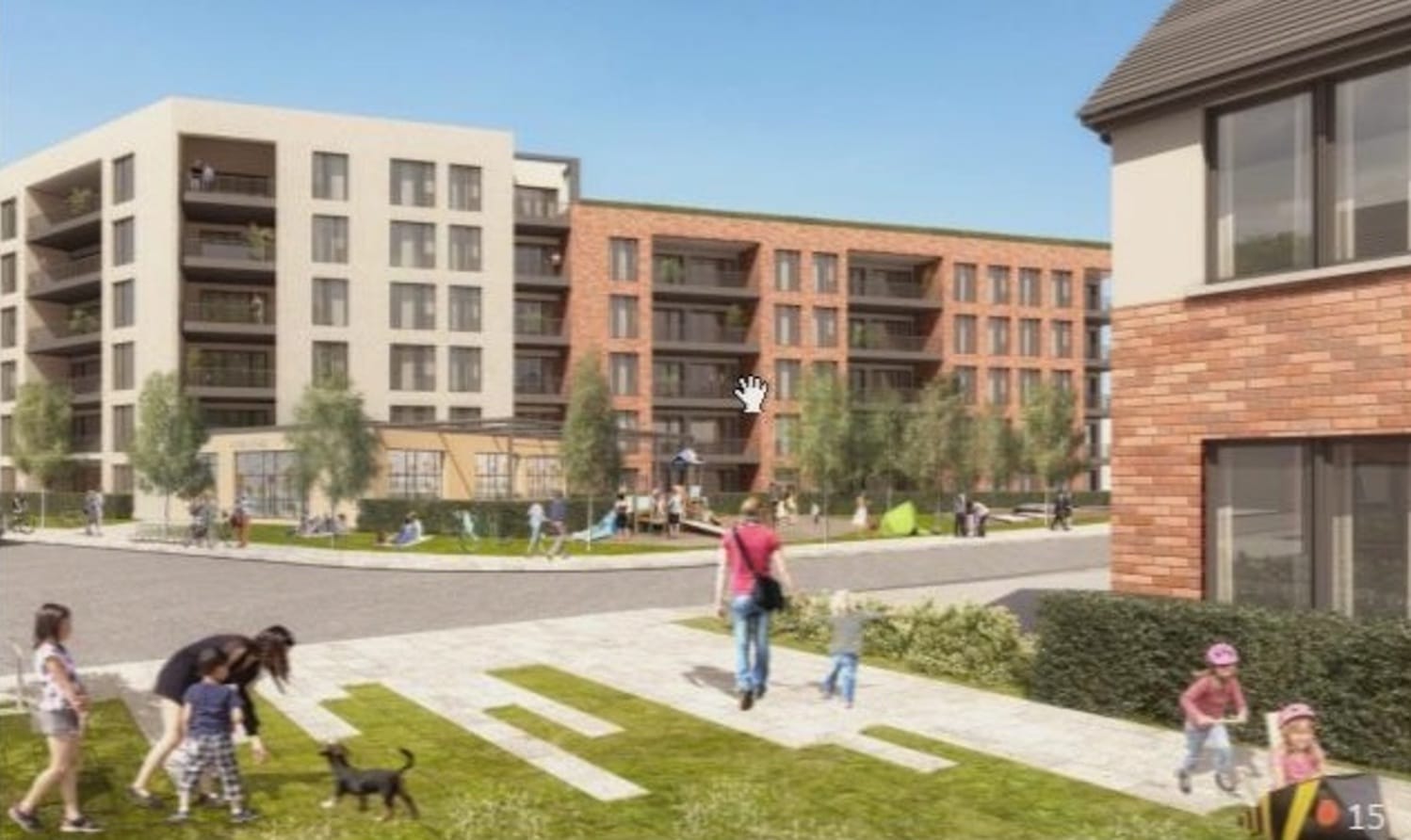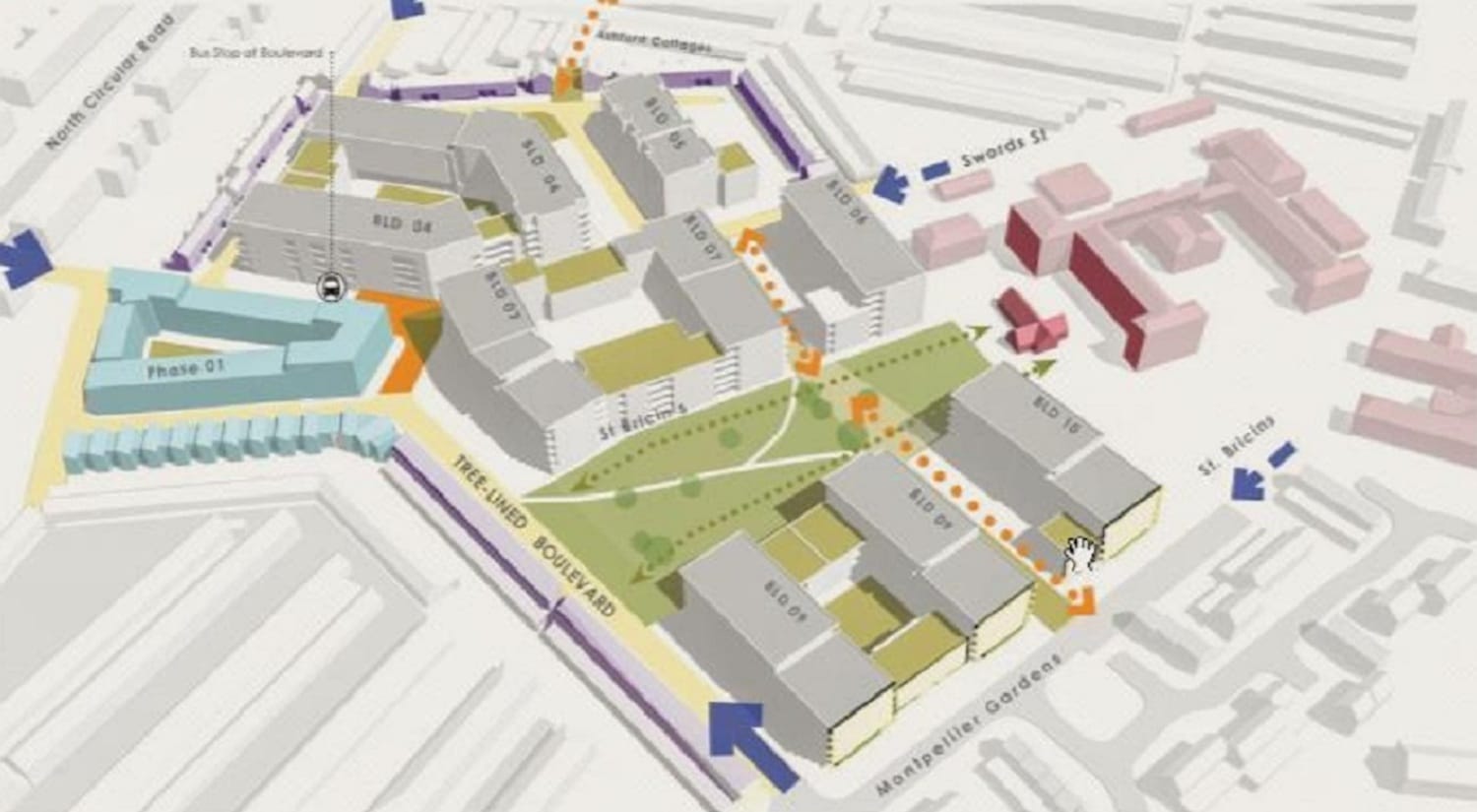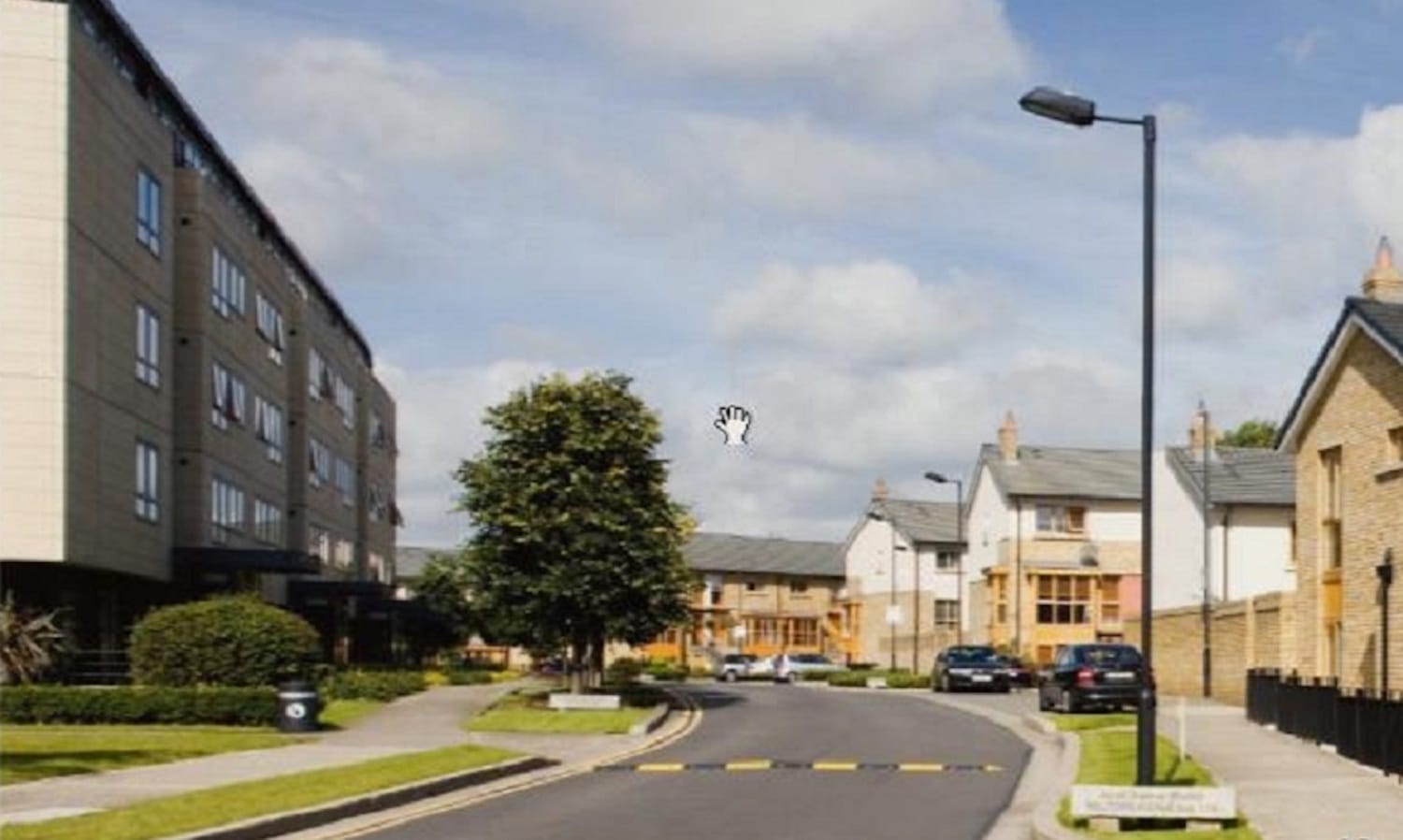What’s the best way to tell area residents about plans for a new asylum shelter nearby?
The government should tell communities directly about plans for new asylum shelters, some activists and politicians say.
Part of the discussion focused on why the council had opted for affordable homes to sell, rather than to rent – and whether it was possible to revisit that.

“As you can see, the site, it’s a fabulous site,” said John O’Mahony, from O’Mahony Pike Architects at a council meeting at City Hall on Tuesday.
Behind him on a big screen was a bird’s-eye map showing the squashed hexagon of land that makes up O’Devaney Gardens in Stoneybatter. “I think it’s probably the best site in the north inner-city.”
Councillors from other areas of the city dropped into the meeting too, for a first glimpse of the detailed plans for the council-owned plot, which was earmarked to be developed by a private developer under a process started by the council years ago.
Of six bidders, the council has chosen Bartra Capital Property – who’ve been working with architects O’Mahony Pike – as its preferred winner to develop homes and amenities on the roughly 14 acre site.
Much of the discussion tended towards a post-mortem on how the council got to where it is – a plan for 30 percent social housing, 20 percent “affordable-to-buy”, and 50 percent private – and whether it was the best it could get.
“It’s a high-density area,” said O’Mahony, as he walked councillors through the plans for 824 homes in blocks of up to six storeys.
Neighbourhoods nearby count 169 dwellings per hectare. This, though, would be 145 dwellings per hectare, he said.
He stressed the connections and routes through the site. There would be a tree-lined boulevard from north to south through the west of the site, linking North Circular Road and Montpelier Gardens. Local streets would cross the site from east to west, with shops and community hubs, he said.
There would also be secondary routes to the east, with what he called “home zones” or “small cul-de-sac spaces”, where pedestrians and cyclists have priority, he said.
“Connected in off that are all of the main spaces, the pocket park, the main open park, but also connections along the streets that are leading into the surrounding neighbourhoods,” he said.
They’ve aligned the central space, a long landscaped park with play facilities, with a vista onto the red-brick St Bricin’s Military Hospital.
“I suppose what we were trying to do here is we were trying to create a sense of place,” he says. “That this becomes a new, distinctive part of the city.”

### Bike Lanes, Creches, and Community Centres
At the meeting, councillors asked questions about the details of design – and, in particular, about whether the community facilities would come first, so future residents didn’t find themselves living without amenities.
“I see a lot of cars. I see a very, very much status-quo understanding of how pedestrian space works. Those blocks do not look permeable to me,” said Neasa Hourigan of the Green Party.
Labour’s Alison Gilliland said she wanted to check there were cycle lanes on all the routes. “We have to put cycle lanes from now on in my view in everything we build.”
Gary Gannon, of the Social Democrats, queried what the deal would be with planned creches and affordability. “Will those be remaining in public ownership?”
Community infrastructure has to come first, said Fianna Fáil’s Mary Fitzpatrick. “There must be a commitment that it’s frontloaded in the development.”
Hugh McKenna, the council’s senior executive officer, said he expected that they would find a way to front-load the community centres.
Of the 824 homes on the site, 411 would be private, 165 would be affordable, and 248 would be social, said a council report from deputy chief executive Brendan Kenny. (Of those, 56 are social homes already being built separately.)
In 1954, there were 272 social homes at O’Devaney Gardens, the same report said.
“Absolutely ridiculous,” said independent Councillor Cieran Perry, who opposes the plan and says the council should have pursued a wholly public development.
Gannon, of the Social Democrats, also said it would be better to have only public housing on the site.
But he asked whether voting against the proposed development could achieve that. “What’s the actual likelihood of having public housing on that site, if this wasn’t to go through?”
Debate over what should go on the site goes back years. Council officials began in 2014 to look at ways to develop some of the council’s biggest tracts of land, under what is now known as the Housing Land Initiative.
In 2015, then-head of housing Dick Brady asked for proposals from the private market on developing the land with the council. At that time, many councillors talked about wanting a mix of private, social, and some kind of affordable housing.
In early 2016 councillors voted to back a Sinn Féin motion for 30 percent social homes on the site, rather than the 10 percent that would be standard – a chunk that the Department of Housing later agreed to fund.
In mid-2016, Workers’ Party Councillor Éilis Ryan briefly won backing for it to be all mixed-income public housing – before that was overturned by another vote, and the plan reverted to 30 percent social, 20 percent affordable, and 50 percent private.
At the time, Kenny wrote in an email to Ryan that a change like that would not be compatible with the planning permission or development plan. Also, “it is essential to avoid as much as possible the mistake of building large scale local authority owned estates”, he wrote.
In January 2017, councillors vote to go ahead with the existing plans – and the procurement process kicked off.
On Tuesday, Fitzpatrick of Fianna Fáil said that the fact that central government was only providing funding for 30 percent of the homes on the site to be public was indicative.
“I think that underlines a lack of commitment to providing affordable housing for working people in our city,” she said.
Said Labour’s Gilliland: “I don’t think there’s anybody in the chamber who wouldn’t prefer that mix to be more on the side of public than private.”
The plan was evidence of the council’s lack of autonomy, building capacity and funding, she said. “We’ve been through a journey on this, and we fought the department on this.”
What’s on the table might not be the best, but it’s what’s possible given the make-up of the central government, said Sinn Féin’s Janice Boylan, who grew up in O’Devaney Gardens.
“Telling people that we can deliver something more is lies, it’s absolute lies,” said Boylan, who backs pressing ahead. “We have to move forward with projects that we can deliver, not wishful pie in the sky.”
McKenna, the council executive, stressed that the homes that are built would be “tenure blind” – built the same whether social, affordable, and private.
There would be no studio apartments, no shared accommodation and no student accommodation, he said. “So it’s simply more suitable for families,” he said.
While 50 percent of the homes would be sold by the developer at market prices, these would only account for 22 percent of the land, he said. “No matter what way you parse it, that’s 824 new homes in the city.”

### Affordable, Defined
Once built, the “affordable” homes would be sold at fixed prices, with a 30–40 percent discount, the report says.
This would be possible courtesy of a developer discount, funding from central government through the serviced site scheme, and the deferral of development levies.
Prices for two-bedroom houses would range from €270,000 to €315,000. Three-bed houses were listed for €300,000 to €350,000.
One-bed apartments prices would range from €237,000 to €276,000, two-bed apartments from €303,000 to €354,000, and three-bed apartments from €360,000 to €420,000, the report says.
Perry, the independent councillor, said he doubted the vast majority of local residents would be able to afford these homes. “Certainly, they won’t be able to afford the private houses. But even the affordable ones, I don’t believe they will,” he said.
Boylan, of Sinn Féin, disputed that. “How dare anybody in this chamber assume to know what people’s incomes are and assume to think that they won’t be able to afford an affordable option,” she said.
In January 2017, when councillors voted to press ahead, it had looked as if the “affordable” homes would be to rent, rather than to buy – so they would stay long-term in council hands.
McKenna said the council did a feasibility study on three options: affordable rental, cost rental, and affordable purchase.
There was one main reason they didn’t go for rental, he said. “Simply, there wasn’t a scheme in place at the time we went to market.”
In other words, central government hadn’t developed legislation and detailed guidelines setting out how affordable rental projects run by local authorities would work.
A council report also lists some advantages the council thinks affordable purchase has over affordable rental: it “adds to tenure diversity” and strengthens social cohesion “by reducing the short term occupation associated with the rental market”.
It’s a more straightforward model for companies bidding for the development contracts, and it avoids the costs of the long-term administration of rental properties, the report says.

Some councillors wanted to see the cost-benefit analysis that compares the options. McKenna said they would.
But it’s sensitive right now, he said. “We haven’t signed the contract yet and we’re a bit reluctant to show our hand.”
Switching from affordable purchase to some kind of cost rental wouldn’t be possible at this stage, said McKenna.
Legal advice said the council would be left open to legal challenge, compensation claims, and damaging delays – which, with construction inflation, would lead to a hike in the budget, he says. “We’ve gone as far as we’ve gone with regards to that.”
Labour’s Marie Sherlock said she wanted to see the legal advice, too. “It’s not good enough to put up excerpts or lines from the legal advice.”
Said O’Mahony, the architect, as he wrapped up: “I think probably consideration must now be given now to what is the name of this place? What should it be in the future?”
Later, when it was his turn to speak, independent councillor Nial Ring had one suggestion: “Possibly, the name should be, ‘Opportunity Lost’,” he said.
Councillors will have to vote at their full council meeting on whether or not to press ahead with plans.
Once the council signs the development agreement, Bartra has six months to apply for planning permission, McKenna told councillors.
Get our latest headlines in one of them, and recommendations for things to do in Dublin in the other.